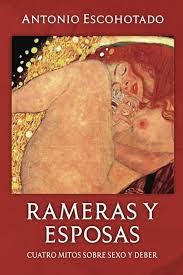
Idioma original: castellano
Year of publication: 1993
Valuation: Alright
This book by Antonio Escohotado comes into my hands, somewhat by chance, and I admit that I was not very keen on reading it. It is not a good thing to read with a certain reluctance, although sometimes you find pleasant surprises, you never know. Apparently it is a reworking of an earlier text (1978), which had the less impressive title of Family storiesalthough the subtitle is preserved Four myths about sex and dutyEscohotado’s resume is so overwhelming, in volume and subject matter, that one can almost expect anything, although at first glance it seems that it will be somewhat or quite controversial.
I cannot be sure, but I dare say no. I see no intention, as one might suppose, to describe in any way the position of women in history, not even in the ancient world, but rather to analyse certain power relations in the sphere of couples through the study of four of them, all inscribed in the field of myth or legend: Ishtar and Gilgamesh, Zeus and Hera, Hercules and Deianira, Mary and Joseph. The first three stories are presented clearly and simply, revealing some of the forces that move these relationships: seduction, jealousy, the sense of possession, fidelity or its absence, revenge. Aspects that in these classic narratives have an inevitable, and very marked, tragic character.
The biblical account, on the other hand, naturally includes the Marian parthenogenesis that has entertained so many for centuries. But in the book, that is not the central issue, but rather the figure of Mary herself, who assumes the role of mother of the Chosen One to its ultimate consequences, a conviction that guides her conduct and defines, without possible revision, the relationships in the small family. Rather surprisingly, Escohotado follows to the letter and without contrast a good number of passages from the so-called ‘apocryphal gospels’, which gives rise to a rather strange effect that seems to have been deliberately sought: the biblical account, including the characterization of its main characters, can perfectly be assimilated to the atmosphere of the ancient myths that have been previously presented.
It is not easy for me to draw conclusions from the book either, perhaps it is not intended to do so. I understand it as an analysis of those family or couple relationships from the point of view of male and female roles, especially from the latter. However, it can be deduced that, according to the author, women, neglected in so many aspects of civil life, have not stopped handling powerful weapons with which to confront their disadvantages, often in the private sphere, but often transcending, and in what way, to the outside. Hence the emphasis on the figure of sacred prostitutes, hierodules or hetairas, with other names in different cultures, whose influence was decisive at more times than one might suppose.
Ultimately, Escohotado seems to say, it is to some extent a struggle for power, power in general, or power over others. Those mythical women display, for example, their invincible gifts of seduction, sufficient to subdue any force, and in any case they hold the great key of motherhood, which weaves alliances, plots betrayals or empowers the generating, protective or manipulative mother, as the case may be. It occurs to me that these four stories may not be enough material to build much more than an outline, a few quick notes on surely relevant aspects that border on anthropology or psychology, but do not end up constituting a solid theoretical body.
They may serve as a source of information and a point of reflection, but perhaps we cannot ask for much more.
Source: https://unlibroaldia.blogspot.com/2024/08/antonio-escohotado-rameras-y-esposas.html


